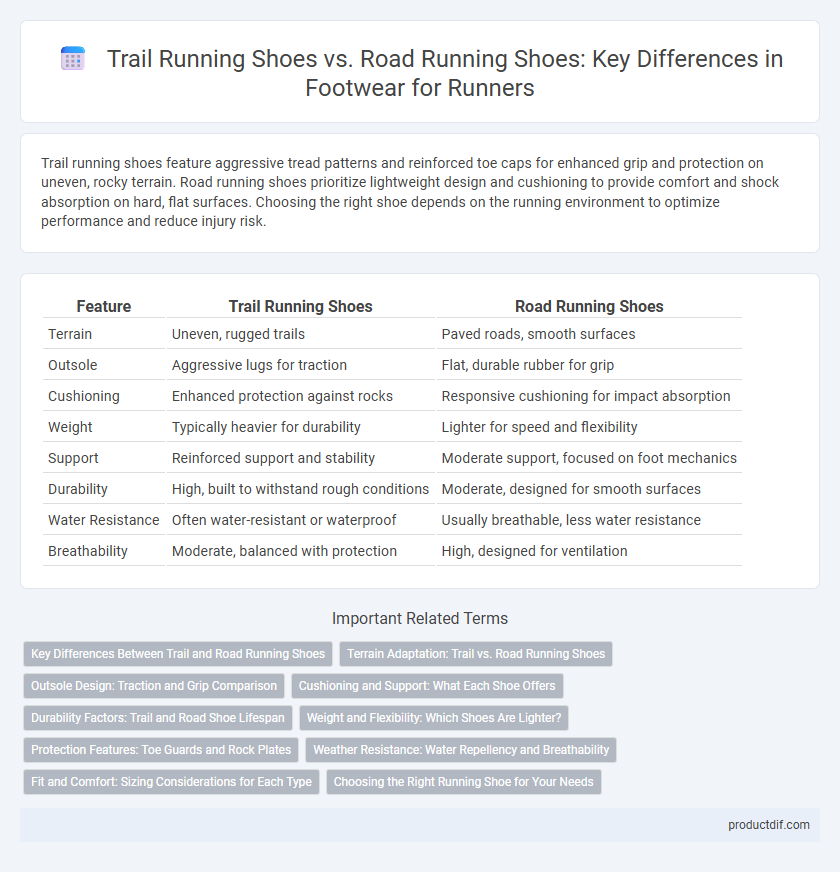Trail running shoes feature aggressive tread patterns and reinforced toe caps for enhanced grip and protection on uneven, rocky terrain. Road running shoes prioritize lightweight design and cushioning to provide comfort and shock absorption on hard, flat surfaces. Choosing the right shoe depends on the running environment to optimize performance and reduce injury risk.
Table of Comparison
| Feature | Trail Running Shoes | Road Running Shoes |
|---|---|---|
| Terrain | Uneven, rugged trails | Paved roads, smooth surfaces |
| Outsole | Aggressive lugs for traction | Flat, durable rubber for grip |
| Cushioning | Enhanced protection against rocks | Responsive cushioning for impact absorption |
| Weight | Typically heavier for durability | Lighter for speed and flexibility |
| Support | Reinforced support and stability | Moderate support, focused on foot mechanics |
| Durability | High, built to withstand rough conditions | Moderate, designed for smooth surfaces |
| Water Resistance | Often water-resistant or waterproof | Usually breathable, less water resistance |
| Breathability | Moderate, balanced with protection | High, designed for ventilation |
Key Differences Between Trail and Road Running Shoes
Trail running shoes feature aggressive outsoles with deep lugs for enhanced traction on uneven, rocky terrain, while road running shoes have smoother, more flexible soles designed for pavement and hard surfaces. Trail shoes offer reinforced toe caps and durable materials to protect against debris and rough conditions, contrasting with the lightweight, breathable construction of road shoes optimized for speed and comfort. Cushioning in trail shoes is generally firmer to provide stability on unpredictable trails, whereas road running shoes prioritize shock absorption for repetitive impact on flat surfaces.
Terrain Adaptation: Trail vs. Road Running Shoes
Trail running shoes are designed with aggressive outsoles featuring deep lugs that provide superior traction on uneven, rocky, and muddy terrains, enhancing stability and grip on trails. In contrast, road running shoes have smoother, flatter soles optimized for hard, even surfaces like pavement or asphalt, offering cushioning and support for repetitive heel strikes on hard ground. Both types of shoes prioritize terrain adaptation by balancing durability and flexibility, with trail shoes emphasizing protection against debris and road shoes focusing on shock absorption for consistent surfaces.
Outsole Design: Traction and Grip Comparison
Trail running shoes feature aggressive lug patterns and durable rubber outsoles designed to provide superior traction on uneven, slippery, and rocky terrain. Road running shoes prioritize smoother, flatter outsoles made from carbon rubber that optimize grip on paved surfaces while enhancing flexibility and shock absorption. The distinct outsole designs reflect their specialized use, with trail shoes emphasizing multi-directional grip and road shoes focusing on consistent traction and smooth transitions.
Cushioning and Support: What Each Shoe Offers
Trail running shoes provide enhanced cushioning and support designed to absorb shocks from uneven terrain and protect against rocks and roots, featuring sturdier midsoles and rugged outsoles for stability. Road running shoes prioritize lightweight cushioning that offers consistent shock absorption on hard, flat surfaces, often utilizing responsive foam to reduce impact on joints. Both types optimize support based on terrain demands, with trail shoes emphasizing durability and foot protection while road shoes focus on flexibility and smooth gait transitions.
Durability Factors: Trail and Road Shoe Lifespan
Trail running shoes typically feature reinforced materials and rugged outsoles designed to withstand abrasive terrains, resulting in enhanced durability compared to road running shoes. Road running shoes often incorporate lightweight, flexible materials optimized for pavement, which can lead to faster wear and a shorter lifespan under heavy use. Factors such as terrain type, running frequency, and shoe construction directly influence the lifespan, with trail shoes generally lasting longer in harsh environments due to their robust build.
Weight and Flexibility: Which Shoes Are Lighter?
Trail running shoes typically weigh more than road running shoes due to added protective features like reinforced soles and rugged outsoles designed for rough terrain. Road running shoes prioritize lightweight materials and enhanced flexibility to improve speed and comfort on smooth pavement. Choosing between the two depends on whether weight savings or durability for uneven surfaces is the primary concern.
Protection Features: Toe Guards and Rock Plates
Trail running shoes feature reinforced toe guards and integrated rock plates designed to protect feet from sharp rocks, roots, and uneven terrain, ensuring enhanced durability and impact resistance. Road running shoes typically lack these protective elements, prioritizing lightweight construction and cushioning for smooth, predictable surfaces like pavement. The specialized protection in trail shoes significantly reduces the risk of foot injuries in rugged outdoor environments.
Weather Resistance: Water Repellency and Breathability
Trail running shoes typically feature enhanced water repellency with durable, waterproof membranes like Gore-Tex to protect against wet, muddy conditions while maintaining breathability through specialized mesh panels. Road running shoes prioritize superior breathability using lightweight, highly ventilated materials to optimize airflow and moisture wicking, though they generally lack robust water-resistant properties. Weather resistance in trail shoes balances water protection without sacrificing breathability, whereas road shoes emphasize ventilation for dry, paved surfaces.
Fit and Comfort: Sizing Considerations for Each Type
Trail running shoes typically require a snugger fit to provide stability and prevent debris from entering, often featuring reinforced toe caps and more structured uppers. Road running shoes prioritize cushioning and breathability, demanding a slightly roomier fit to accommodate foot swelling during extended use. Proper sizing differences ensure optimal comfort and performance, with trail shoes benefiting from a secure fit and road shoes allowing for natural foot expansion.
Choosing the Right Running Shoe for Your Needs
Trail running shoes feature rugged outsoles with deep lugs for superior traction on uneven, rocky terrain while providing enhanced foot protection against roots and debris. Road running shoes prioritize lightweight construction and cushioning to absorb impact on hard, flat surfaces such as asphalt or concrete. Selecting the right running shoe depends on terrain type, with trail shoes optimizing stability and durability for off-road conditions and road shoes focusing on comfort and shock absorption for pavement running.
Trail running shoes vs Road running shoes Infographic

 productdif.com
productdif.com